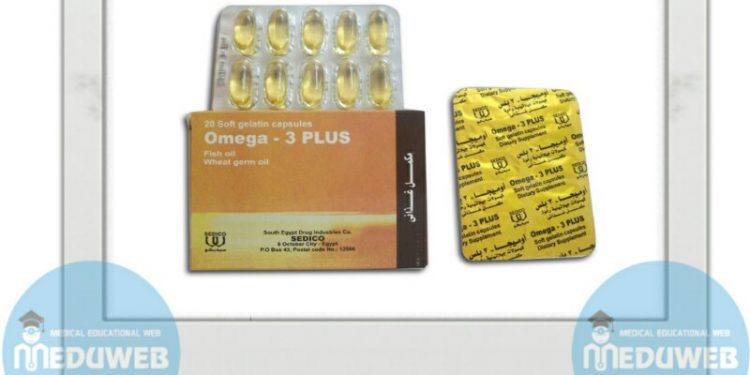Omega – 3 Plus capsules Composition:
Each soft gelatin capsule contains:
Fish Oil 1000 mg
( Contains Eicosapentaenoic acid minimum(EPA) 13% & Docosahexaenoic
acid minimum (DHA) 9% )
wheat germ oil (Linoleic Acid 52 – 59 %) 100 mg
Omega – 3 Plus capsulesIndications:
Dietary supplement (as a source of Omega-3).

Omega – 3 Plus capsules Dose:
One Capsule 3 times daily or as directed by the physician.
Omega – 3 Plus capsules Warnings & Precautions:
To be used under medical supervision.
– Keep medicine out of reach of children.
– Contraindication with hypersensitivity to omega-3 acid ethyl
esters, fish allergy.
– Used with caution in patients with coagulopathy or taking
anticoagulant drug.
Omega – 3 Plus capsules Packing:
-20 soft gelatin capsules packed in two ( ALlPVC) strips in a carton box with pamphlet.
Omega – 3 Plus capsules Storage:
– Keep at temperature not exceeding 30° C in dry place.
– Dietary Supplements are not intended to diagnose, treat,
cure or prevent disease
Omega – 3 Plus capsules Produced by :
South Egypt Drug Industries Company SEDICO”
6 October City – Egypt
Fish Oil PPT power point presentation :
1. Case Conference: Omega-3 Polyunsaturated Fatty Acids Group II – Section AALFONSO, ALJAMA, ALUZAN, AMURAO, ARELLANO, ARROYO
2. Case: Omega-3 Fatty Acid Supplementation• A 42-year old male with a strong familial history of coronary heart disease was presently asymptomatic. He read several articles in national magazines and in the newspapers that fish oil capsules may help prevent coronary thrombosis.
3. Case: Omega-3 Fatty Acid Supplementation• Such dietary supplements are available over the counter without a prescription. In an attempt to protect himself against coronary heart disease, he purchased 500 mg fish oil capsules containing 50% omega-3 polyunsaturated fatty acids and ingested six capsules daily.
4. OVERVIEW AND INTRODUCTION
5. Overview and Introduction• POLYUNSATURATED FATTY ACIDS• Straight chain derivatives of fatty acids containing• Two or more double bonds.• ESSENTIAL FATTY ACIDS• Molecules that cannot be synthesized by the human body but are vital for normal metabolism•• One of these essential fatty acids is the• Omega-3 Polyunsaturated Fatty Acids
6. Omega-3 Polyunsaturated Fatty Acids• -essential dietary fatty acids, belonging to the lenolenic family of PUFAs -contain a double bond on the third carbon from the methyl end•• CHIEF DIETARY SOURCES: ocean fishes and fish oils• *Fish oil is obtained in the human diet by eating oily fishes such as herring, mackerel, salmon, albacore tuna, and sardines, or by consuming fish oil supplements or cod liver oil
7. List of the common Omega-3 Fatty Acids
8. Omega-3 Polyunsaturated Fatty Acids• Nutritionally important n−3 fatty acids include α-linolenic acid (ALA), eicosapentaenoic acid (EPA), and docosahexaenoic acid (DHA), all of which are polyunsaturated.
9. α-linolenic acid (ALA)• -type of omega-3 fatty acid found in plants.• -alpha-linolenic acid can be converted into EPA and DHA in the body• -highly concentrated in flaxseed oil and, to a lesser extent, in canola, soy, perilla, and walnut oils.•
10. Eicosapentaenoic acid (EPA)• -EPA acts as a precursor for prostaglandin- 3 (which inhibits platelet aggregation), thromboxane- 3, and leukotriene-5 groups
11. Docosahexanoic acid (DHA)• Obtained directly from fish oil• Present in high concentration in retina, cerebral cortex, testis and sperm• Needed for brain and retinal development
12. FATTY ACIDS RELATED TOMEMBRANES
13. Fatty Acids related to Membranes• plasma membranes – basic component of a eukaryotic cell
14. Fatty Acids related to Membranes• plasma membranes – built utilizing amphiphatic lipids: phospholipids, glycolipids & other amphipatic lipids
Omega – 3 Plus capsules


